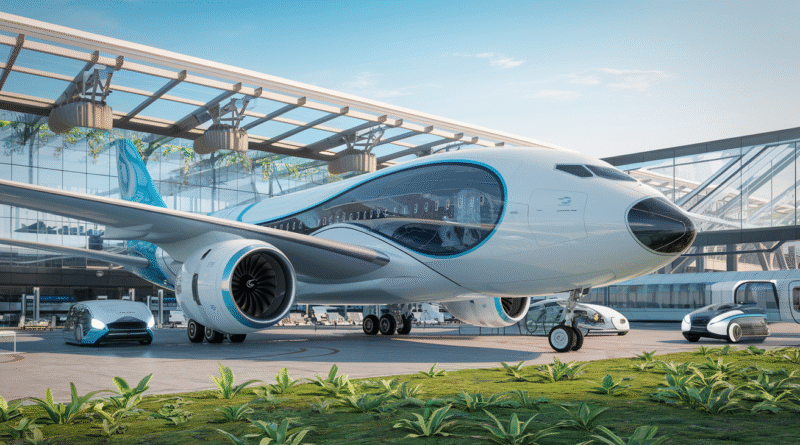The Future of Air Travel : Can Airlines Achieve Zero Emissions by 2050?
Air travel has been widely criticized for its environmental impact, contributing about 2-3% of global carbon emissions. As the urgency to address climate change intensifies, the aviation industry faces significant pressure to reduce its carbon footprint. Airlines, industry leaders, and governments have set ambitious goals to achieve net-zero emissions by 2050. However, with air travel continuing to expand and the industry’s heavy dependence on fossil fuels, achieving this goal remains challenging. Let’s examine the future of air travel and the strategies that could enable airlines to reach zero emissions by 2050.
Understanding the Challenge: The Aviation Industry’s Carbon Footprint
Airplanes depend on fossil fuels, specifically jet fuel, which emits large amounts of CO2 when burned. Although aviation represents a relatively small percentage of global emissions, it is one of the most difficult sectors to decarbonize due to its operational complexities and the slow pace of technological advancements. Reaching zero emissions by 2050 will require overcoming multiple hurdles, including technological limitations, regulatory challenges, and economic factors.
Key obstacles include:
- High energy demand: Aircraft, especially for long-haul flights, require enormous amounts of energy, making the switch to cleaner energy sources difficult.
- Lack of viable alternatives: Although electric and hydrogen-powered planes are in development, these technologies are still in their early stages and not ready for large-scale use.
- Slow fleet turnover: Airplanes often remain in service for 20-30 years, so even if cleaner aircraft are introduced, it will take decades to replace the current fleet.
Pathways to Zero Emissions: Emerging Technologies and Strategies
Despite these challenges, the aviation industry is exploring various pathways to meet its net-zero emissions goal. These include fuel efficiency improvements, the development of sustainable aviation fuels (SAFs), electrification, hydrogen-powered aircraft, and carbon offsetting.
- Sustainable Aviation Fuels (SAFs)
One of the most promising solutions is the use of SAFs, biofuels produced from renewable sources such as algae, waste oils, and agricultural byproducts. SAFs can reduce lifecycle carbon emissions by up to 80% compared to traditional jet fuel.
Several airlines, including United Airlines and British Airways, are already incorporating SAFs into their operations. However, SAFs face significant challenges:
- Cost: SAFs are currently much more expensive to produce than conventional jet fuel, which makes them less appealing for airlines with slim profit margins.
- Supply constraints: Limited production capacity and the need for significant investment to scale up SAF production pose major hurdles.
Despite these obstacles, SAFs offer one of the most feasible short- to medium-term solutions for cutting aviation emissions.
- Electric and Hybrid Aircraft
Electric and hybrid-electric aircraft are emerging as potential solutions for short-haul flights. These aircraft use electric motors powered by batteries or hybrid systems combining batteries with conventional engines. Electric planes generate zero emissions during flight and have the potential to make air travel more sustainable.
Several companies are developing electric aircraft:
- Rolls-Royce and Airbus are collaborating on hybrid-electric propulsion systems for regional jets.
- Wright Electric is working on a fully electric passenger plane for short-haul flights by the 2030s.
However, there are key challenges:
- Battery limitations: Current batteries are too heavy and lack the energy density required for long-haul flights, limiting electric planes to short distances for now.
- Infrastructure: Airports and airlines will need to invest in charging infrastructure to support electric aircraft.
While electric planes may not yet be suitable for long-haul flights, they could significantly reduce emissions on regional routes.
- Hydrogen-Powered Aircraft
Hydrogen has the potential to revolutionize zero-emissions aviation. Hydrogen-powered aircraft would use fuel cells to generate electricity, emitting only water vapor. Companies like Airbus aim to bring hydrogen-powered commercial planes to market by 2035.
Advantages of hydrogen include:
- Zero emissions: Hydrogen does not produce CO2 when used as fuel, offering a clean alternative to fossil fuels.
- High energy density: Hydrogen’s higher energy density compared to batteries makes it more suitable for long-haul flights.
Challenges include:
- Infrastructure: The production, storage, and distribution of hydrogen require extensive new infrastructure.
- Safety concerns: Hydrogen is highly flammable, raising safety questions in aviation.
Despite these hurdles, hydrogen-powered planes could be crucial in reducing emissions for medium- to long-haul flights.
- Carbon Offsetting and Carbon Capture
In the short term, airlines are turning to carbon offsetting programs, which allow them to invest in environmental projects that reduce CO2 emissions, such as reforestation and renewable energy. Carbon capture technologies, which remove CO2 from the atmosphere, are also gaining interest but are still in the early stages and require substantial investment.
Regulatory and Policy Support
Achieving zero emissions by 2050 will require robust regulatory and policy support. Organizations like the International Civil Aviation Organization (ICAO) have set global targets for reducing aviation emissions, but achieving these goals will demand coordinated action across borders.
Key regulatory strategies include:
- Carbon taxes: Governments may implement carbon taxes to encourage airlines to adopt cleaner technologies.
- Incentives for sustainable tech: Subsidies and tax breaks could be provided for airlines investing in sustainable aviation technologies like SAFs or electric aircraft.
- Global agreements: International agreements may be needed to ensure consistent commitments from all countries and airlines in reducing emissions.
The Path Forward: Can Airlines Achieve Zero Emissions?
While significant challenges remain, the aviation industry is making progress towards achieving zero emissions by 2050. By combining SAFs, electric and hydrogen-powered aircraft, carbon capture, and offsetting programs, the industry is adopting a multi-faceted approach to reducing its carbon footprint.
However, reaching this goal will require collaboration between airlines, governments, and the private sector. Investments in research, infrastructure, and policy support will be essential to making these technologies viable on a global scale.
Conclusion: A Long Road to Zero Emissions
The future of air travel is at a turning point. While achieving zero emissions by 2050 is ambitious, it is not unattainable. The industry is investing in innovative technologies such as sustainable fuels, electric planes, and hydrogen-powered aircraft that could significantly reduce aviation’s environmental impact. With the right investments, policies, and consumer support, the aviation industry could play a pivotal role in the fight against climate change.

